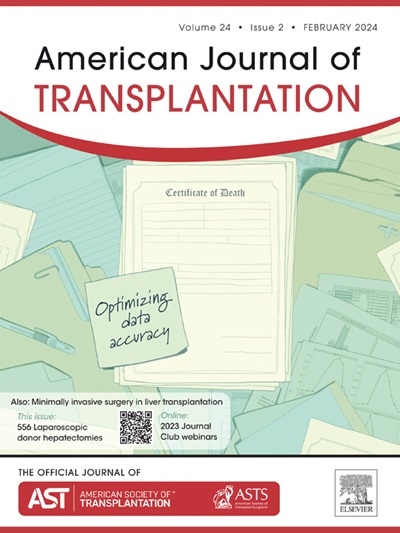Changes in characteristics of recovered U.S. deceased donor kidneys lead to large changes in KDRI-to-KDPI scaling over time.
IF 8.2
2区 医学
Q1 SURGERY
引用次数: 0
Abstract
The Kidney Donor Risk Index (KDRI) was introduced into the US kidney allocation system in 2014 as an estimate of the relative risk of post-transplant deceased donor kidney allograft failure in an adult recipient. It is scaled annually relative to the prior year's cohort of donors and converted to a percentile score known as the Kidney Donor Profile Index (KDPI), with higher scores suggesting shorter estimated function. This retrospective cohort study examined all deceased donor kidneys recovered for transplantation from 2016-2023 (N=187,817) to examine the extent to which the KDRI of organs with equivalent KDPI percentage score is changing. Median KDRI stayed constant or trended upwards annually-KDPI 50% kidneys in 2018 were KDRI 1.2 (0.96-1.56) compared to KDRI 1.4 (1.06-1.79) in 2023. The change in KDPI for identical donors ranged from 8% to 14%. KDPI 84% kidneys in 2023 had a KDRI of 1.97, which were KDPI 92% kidneys in 2016. The new KDRI equation, modeled without donor race and hepatitis C factors, showed greater clustering of KDRI values, consistent with a lower number of variables. Although kidneys may be represented by the same percentile score, the underlying drift of the KDRI may result in very different estimated longevity.美国已故供者肾脏的特征变化导致kdri - kdpi随时间的变化。
肾供体风险指数(KDRI)于2014年引入美国肾脏分配系统,用于评估成人受体移植后死亡供体肾移植衰竭的相对风险。它每年相对于前一年的捐赠者队列进行缩放,并转换为百分位数得分,称为肾脏捐赠者概况指数(KDPI),分数越高表明估计功能越短。本回顾性队列研究检查了2016-2023年间所有因移植而恢复的已故供体肾脏(N=187,817),以检查具有等效KDPI百分比评分的器官的KDRI变化程度。KDRI中位数保持不变或呈逐年上升趋势,2018年50%肾脏的kdpi为KDRI 1.2(0.96-1.56),而2023年为KDRI 1.4(1.06-1.79)。相同供体的KDPI变化从8%到14%不等。2023年KDPI为84%的肾脏KDRI为1.97,2016年KDPI为92%。新的KDRI方程,不考虑供体种族和丙型肝炎因素,显示出更大的KDRI值聚类,与更少的变量一致。虽然肾脏可以用相同的百分位分数来表示,但KDRI的潜在漂移可能导致非常不同的估计寿命。
本文章由计算机程序翻译,如有差异,请以英文原文为准。
求助全文
约1分钟内获得全文
求助全文
来源期刊
CiteScore
18.70
自引率
4.50%
发文量
346
审稿时长
26 days
期刊介绍:
The American Journal of Transplantation is a leading journal in the field of transplantation. It serves as a forum for debate and reassessment, an agent of change, and a major platform for promoting understanding, improving results, and advancing science. Published monthly, it provides an essential resource for researchers and clinicians worldwide.
The journal publishes original articles, case reports, invited reviews, letters to the editor, critical reviews, news features, consensus documents, and guidelines over 12 issues a year. It covers all major subject areas in transplantation, including thoracic (heart, lung), abdominal (kidney, liver, pancreas, islets), tissue and stem cell transplantation, organ and tissue donation and preservation, tissue injury, repair, inflammation, and aging, histocompatibility, drugs and pharmacology, graft survival, and prevention of graft dysfunction and failure. It also explores ethical and social issues in the field.

 求助内容:
求助内容: 应助结果提醒方式:
应助结果提醒方式:


